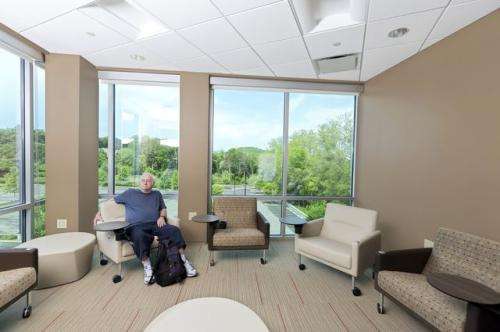Independent-minded baby boomers face limited housing options

While Americans are living longer and remaining relatively healthy, they are decidedly not interested in spending their golden years in assisted living or skilled nursing homes, a panel of experts unanimously agreed at a recent UCLA Anderson conference "Preparing for the Senior Tsunami: The Future of Affordable Housing and Long-Term Care."
But with baby boomers already making up 35 percent of the U.S. population and with 45 percent of them already past 50, the question of how to provide affordable housing for these independent-minded baby boomers spurred discussion among experts in aging and housing at the event, presented by the UCLA Ziman Center for Real Estate in partnership with Mercy Housing, a national not-for-profit affordable housing organization that serves families, veterans, seniors and people with special needs, including the formerly homeless and developmentally disabled.
California has 1,100 skilled nursing facilities, more than anywhere else in the nation. Most are severely outdated and "designed for task-centered care," said long-term care consultant and panelist David Farrell. Boomers culturally aren't inclined to the multi-bed/shared bathroom model of most such facilities.
This is a demanding cohort, said Fernando Torres-Gil, director of the Center for Policy Research on Aging and a professor at the UCLA Luskin School of Public Affairs. But they are in rather deep denial about what longevity really means—especially about how to pay for a combination of independent living and the increasing medical care and social services they are likely to need.
"Seventy-eight million ornery, demanding, entitled baby boomers are going to wake up and say, 'I'm in a world of trouble,'" Torres-Gil said to the amusement of the audience, which included many 50-somethings.
Programs like Social Security, begun in 1935, and Medicare, dating to 1965, dramatically reduced the number of people living below the poverty line. That success may have convinced the federal government that it's essentially done its part, said Torres-Gil, and Americans can't count on any more entitlements at that level.
Cindy Kauffman, COO at the Institute on Aging, said she strives to integrate communication around individuals' care and living situations, collaborating across services and institutions to help seniors age independently while still participating in communities.
Ben Phillips, regional vice president of health care and housing innovations at Mercy Housing California, cited clinical evidence for positive outcomes of "supportive housing," which caters to residents needing minimal services as well as those needing higher levels of care. The exemplary Mission Creek complex in San Francisco—a Mercy high-rise residence with commercial and community spaces at lobby level—houses many people Phillips described as "liberated" from skilled nursing facilities.
So who is obligated to solve the problem, especially since boomers insist on remaining independent as they age, even though they haven't managed to save as much as their parents and they reside in cities with a high cost of living?
Cities, Torres-Gil said, are realizing they need to prepare for shifts in people's expectations and needs as they age.
The entire panel, in fact, agreed that the most creative and effective solutions will be arrived at locally. And for-profit enterprises with a sense of social responsibility might be the most effective agents for change.
Ziman remains committed, said its executive director Tim Kawahara, to helping to shape and implement policies that support the housing needs of an aging population and demonstrate an investment in communities as part of the community. It's in Ziman's DNA, he said, thanks in large part to the standard set by the Howard and Irene Levine Program in Housing and Social Responsibility.
In 2013, UCLA Anderson EMBA students Matt Heidt, Sanjay Rajagopal, Kinoka Ogsbury, Augustus Gatto and Naomi Chen conducted a Strategic Management Research (SMR) Project with Mercy Housing. It was Ziman's first, and it forged a fruitful connection between Ziman and the national nonprofit.
Phillips said Mercy wanted to launch a new business and the SMR project became the catalyst for a "sophisticated economic model" to achieve that.
"Our challenge was to find a financially viable solution to increasing the supply of affordable senior housing using private equity rather than subsidized capital sources," Heidt said of the students' goal during an interview last fall. "Our team was able to demonstrate that not only could a private equity approach to affordable senior housing be profitable for investors, but government programs like Medicare and Medicaid could reduce spending at the same time." Now Mercy focuses primarily—and with confidence—on property acquisition.
Supportive housing needs to be located in places seniors want to live, but also where amenities and affordable, high-quality medical care and other services are abundant. For example, accessible public transportation, which Torres-Gil called the stepchild of housing, is key.
But certain communities, whether whole towns or specific ZIP codes, might not be terribly welcoming of the kind of re-envisioned housing complexes that Farrell and Phillips see replacing traditional nursing facilities. Torres-Gil, who served for many years on the Los Angeles City Planning Commission, said, "There is a visceral connection between people and their property values." So a significant impediment, unless municipalities impose special zoning, could be the LULU faction—resistance on the basis of "locally undesirable land use."
But there's hope in the fact that these questions are more and more likely to be bipartisan concerns. And that means policy is more apt to change, the panelists agreed. It's fair to say this is the calm before the real storm, and it will take careful planning if we expect to weather it.
Provided by University of California, Los Angeles

















